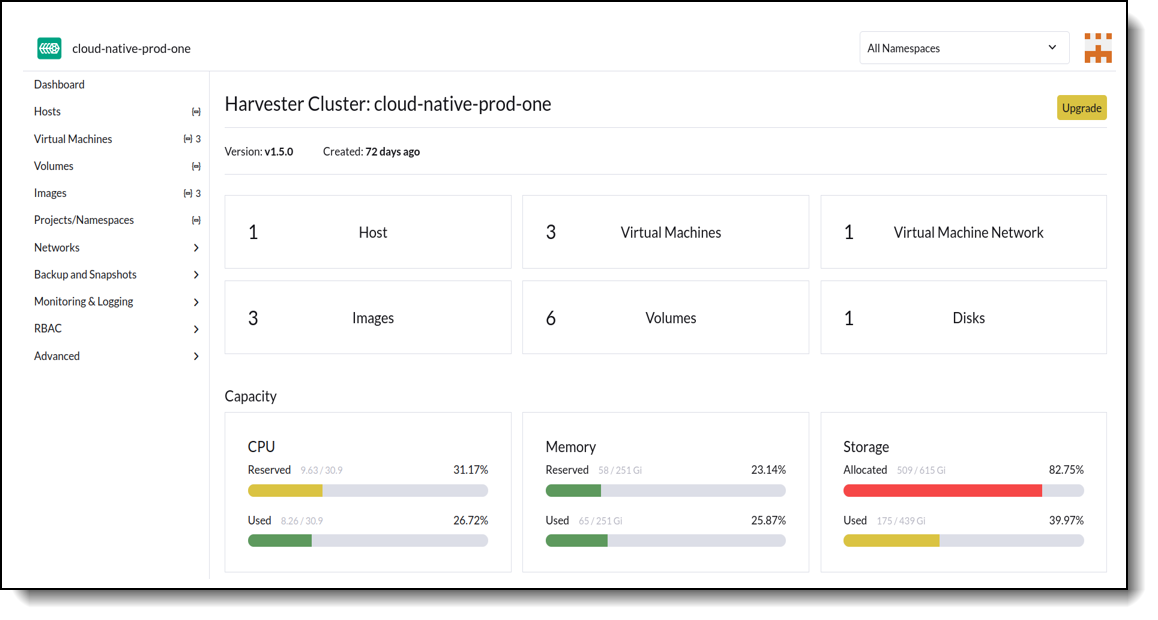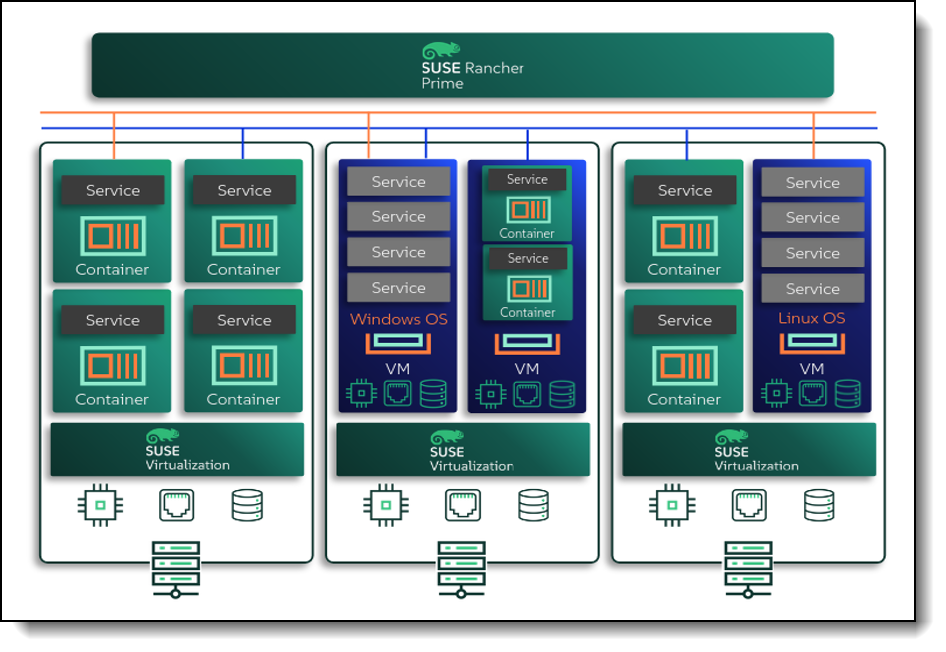Authors
Published
22 Jul 2025Form Number
LP2259PDF size
8 pages, 524 KBSUSE Virtualization
The growth of virtualization and containerization has created a pressing need for compute infrastructure that meets high-performance and high-density workload requirements. Software-defined platforms need to provide robust local storage as well as be able to leverage centralized storage appliances. No longer a simplistic system for hosting virtual machines, today’s cloud-native compute platforms are flexible and scalable architectures capable of meeting any virtualized or containerized workload.
The growing trend towards cost-effective software defined infrastructure allows businesses to reduce their datacenter footprint while maintaining high performance and low-latency objectives for modern workloads.
Managing Virtualization and Cloud-Native Workloads: The slow, but steady growth of virtual machines paired with the rapid adoption of containerized applications is driving an ever-greater need for virtual machines and container workloads to live as first-class citizens on a single compute platform.

Figure 1. SUSE Virtualization’s clean, easy to navigate virtual machine user interface.
SUSE Virtualization lowers costs by running containerized applications directly on the bare-metal servers. This provides better performance and resource utilization as compared to other platforms that must create additional virtual machines to support Kubernetes workloads.

Figure 2. SUSE Virtualization’s full-featured Kubernetes workload user interface.
Many businesses are struggling to maintain legacy applications but are also overwhelmed by the idea of modernizing them into a containerized architecture. SUSE Virtualization provides a fantastic steppingstone approach to modernizing applications since both the newly containerized portions and the remaining virtualized portions run on the same platform, even within the same resource and security constraints. Thus, developers can modernize their applications at a pace that makes the most sense for them and the organization, while maintaining the entire application stack on the production platform.
Overall, with SUSE Virtualization, IT teams gain an enterprise-grade, open-source solution that simplifies deployment and management while improving operational efficiency. Businesses gain the ability to consolidate enterprise virtualized and containerized workloads on a much more cost-effective and flexible platform.
SUSE Virtualization and SUSE Rancher Prime Solutions on ThinkSystem V3 Servers: Lenovo ThinkSystem V3 systems are the perfect choice for hyperconverged infrastructure and provide an outstanding platform to support the different workloads. Lenovo ThinkSystem V3 servers are equipped with 5 Gen Intel® Xeon® Scalable processors and 5 Gen AMD EPYC processors.
SUSE Rancher Prime is a ubiquitous Kubernetes management platform which provides full lifecycle management to Kubernetes clusters across on-premises and public cloud infrastructure. While SUSE provides two excellent Kubernetes distributions, RKE2 and K3s, SUSE Rancher Prime can manage any CNCF distribution of Kubernetes.
SUSE Virtualization Architecture
SUSE Virtualization is an open source hyperconverged infrastructure (HCI) solution designed for modern cloud native environments. SUSE Virtualization includes the security-focused technologies of RKE2 Kubernetes distribution SUSE Linux Micro. This architecture is the key to running virtual machines alongside bare-metal containerized workloads and is unique to the HCI market. Storage in SUSE Virtualization is replicated across all SUSE Virtualization nodes and thus scales up as the workload and the number of nodes grows.

Figure 3. SUSE Virtualization Architecture.
SUSE Virtualization fully integrates with SUSE Rancher Prime. This integration unifies authentication, authorization, monitoring and management across multiple clusters and environments, simplifying operations, improving governance, and enhancing overall visibility and control. This next-generation design with Lenovo ThinkSystem Servers and SUSE Virtualization eases and scales deployment and operations.
With SUSE Rancher Prime and SUSE Virtualization, IT operators now have access to an enterprise-ready, simple-to-use infrastructure platform that cohesively manages their virtual machines and Kubernetes clusters alongside one another.
SUSE Storage Software Defined Storage Architecture
SUSE Virtualization leverages SUSE Storage, based on Longhorn, which is a horizontally replicated, crash-consistent block storage system. With data replicas distributed across hosts in the cluster, Longhorn ensures no single point of failure and maximum availability. Longhorn’s native read/write/many cloud-native storage meets the needs for any containerized workload and is critical for virtual machine live migration. It is the basis for SUSE Virtualization’s recurring incremental snapshots, S3 or NFS backups, and cross-cluster disaster recovery.
SUSE Virtualization Architecture and Deployment
A fully supported, non-likely-available SUSE Virtualization cluster can start with a single server. Two servers, plus a small witness node, allow for a very cost-effective, highly available container workload and virtualization platform. This configuration is extremely popular for Remote Office and compute intensive Edge environments. With three or more compute nodes, SUSE Virtualization automatically becomes a high capacity, highly available compute platform.
The Next Generation of Virtual Machines
SUSE Virtualization can easily run and support legacy virtual machines just the same as the vendors of yester-year. However, its true strength lies in its ability to create cloud-native virtual instances constructed from composable components such as cloud-enabled operating systems, unique operating system and application updates and configurations, and pass-through devices such as vGPUs. Virtual instances with different capabilities and different use-cases are created by simply mixing new combinations of composable components. Virtual instances can even be created on-demand, alongside containerized workloads through automation, quickly answering the changing needs of the business.
SUSE Rancher Prime Server Subscription Model
The Lenovo SUSE Rancher Prime Suite includes all the software components needed for the entire SUSE Virtualization and SUSE Rancher Prime environment. This includes SUSE Virtualization nodes, SUSE Rancher Prime, and unlimited virtual machines running SUSE Linux Micro. The suite software subscription model simplifies software management and offers tremendous value to large and small organizations. This subscription enables the SUSE Virtualization nodes and all instances of software running on the SUSE Virtualization cluster.
Lenovo ThinkSystem V3 and V4 Servers
All the above information is supported and certified on Lenovo ThinkSystem Servers.
Lenovo ThinkSystem V3 Servers
Lenovo ThinkSystem SR650 V3 (2U) and SR630 V3(1U) systems are equipped with 5th Gen Intel® Xeon® Scalable processors. The 5 Gen Intel Xeon Scalable processors support up to 64 cores, up to 3.9 GHz clock speed, up to 8 TB memory and support PCIe 5.0 and NVMe drives.
Lenovo ThinkSystem SR635 V3 (1U 1P), SR645 V3 (1U, 2P), SR655 V3 (2U, 1P) and SR665 V3 (2U, 2P) systems are featured with 5th generation AMD EPYC™ processors. The AMD EPYC 9005 family of processors offer up to 160 cores, up to 4.0 GHz clock speed, up to 3TB memory, and support PCIe 5.0 and NVMe drives. SUSE Linux Enterprise Server is certified and supported on ThinkSystem V3 servers.
Lenovo ThinkSystem V4 Servers
Lenovo ThinkSystem SR650 V4 (2U) and SR630 V4(1U) systems are equipped with 6th Gen Intel Xeon® 6700 or 6500-series processors. The 6700 or 6500-series processors support up to 86 cores and 172 threads, up to 4.3 GHz clock speed, up to 8 TB memory and support 88x PCIe 5.0 and NVMe drives.
Trademarks
Lenovo and the Lenovo logo are trademarks or registered trademarks of Lenovo in the United States, other countries, or both. A current list of Lenovo trademarks is available on the Web at https://www.lenovo.com/us/en/legal/copytrade/.
The following terms are trademarks of Lenovo in the United States, other countries, or both:
Lenovo®
ThinkSystem®
The following terms are trademarks of other companies:
AMD and AMD EPYC™ are trademarks of Advanced Micro Devices, Inc.
Intel®, the Intel logo and Xeon® are trademarks of Intel Corporation or its subsidiaries.
Linux® is the trademark of Linus Torvalds in the U.S. and other countries.
Other company, product, or service names may be trademarks or service marks of others.
Configure and Buy
Full Change History
Course Detail
Employees Only Content
The content in this document with a is only visible to employees who are logged in. Logon using your Lenovo ITcode and password via Lenovo single-signon (SSO).
The author of the document has determined that this content is classified as Lenovo Internal and should not be normally be made available to people who are not employees or contractors. This includes partners, customers, and competitors. The reasons may vary and you should reach out to the authors of the document for clarification, if needed. Be cautious about sharing this content with others as it may contain sensitive information.
Any visitor to the Lenovo Press web site who is not logged on will not be able to see this employee-only content. This content is excluded from search engine indexes and will not appear in any search results.
For all users, including logged-in employees, this employee-only content does not appear in the PDF version of this document.
This functionality is cookie based. The web site will normally remember your login state between browser sessions, however, if you clear cookies at the end of a session or work in an Incognito/Private browser window, then you will need to log in each time.
If you have any questions about this feature of the Lenovo Press web, please email David Watts at [email protected].
